NATURE → Earth Hazards → Volcanic Euruption
I believe that volcanic eruptions are perhaps the most dangerous of our earth's natural hazards. Volcanoes can either erupt slowly, puring out streams of hot lava or erupt explosively, causing immense physical damage to both local terrain and infrastructure. Volcanic eruptions can also eject vast quantities of ash and gas (carbon and sulpure dioxide) into our atmosphere. Depending on weather conditions, these gases and ash can then severely effect areas far beyond the immediate vicinity of the eruption itself.
Why and where do volcanoes occur?
The crust of our planet is composed of a series of slowly moving oceanic and continental plates "floating" on semi-molten rocks that compose the earth's mantle (plate tectonic theory). Volcanoes are intimately related to the movement and collision of these crustal tectonic plates and occur where:
1) Our crust's tectonic plates are converging (convergent plate boundaries), and where one tectonic plate is being pushed (subducted) below another.
Areas of volcanism assocated with such convergent plate boundaries include a) Indonesia, The Philipins, Japan and the Aluetian Islands where volcanoes are
growing on oceanic crust
(forming Island Arcs) and b) the Cascades Range of the west coast of North America and the Andes of South America where volcanoes are
forming on thicker continental crustal plates (Continental Arcs). These volcanoes together comprise the Pacific Ring of Fire and produce the most
violent volcanic eruptions.
2) Along rift zones in continental crust such as the volcanoes of the East African Rift.
3) At "Hot Spots" under both oceanic and continental crust where magma from the earth's mantle moves closer to the earth's surface through cracks
and fissures, for example, Hawaii in the Pacific Ocean, Yellowstone in continental USA and Iceland in the North Atlantic.
4) Along mid ocean ridges. Eruptions on mid ocean ridges are generally non-violent and are rarely seen because they are covered by deep ocean.
These eruptions add new material to the oceanic crustal plates, and
coupled with the natural convection currents in the earth's mantle
drive oceanic and continental crustal plates into each other.
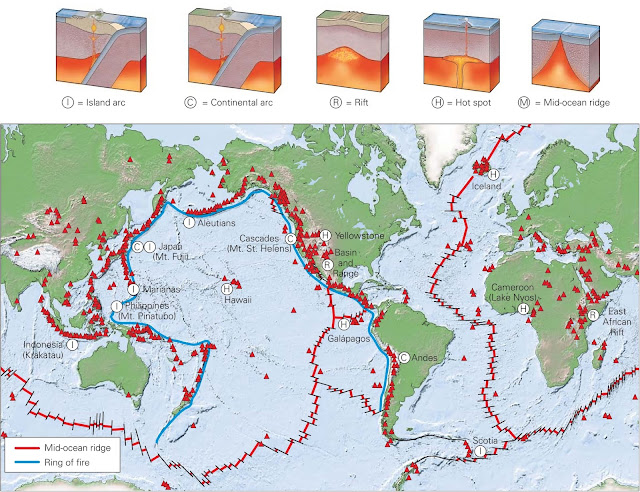
Relationship of volcanic eruptions to crustal plate boundaries
Source:Learning Geology. See: https://geologylearn.blogspot.com/2016/03/relation-of-volcanism-to-plate-tectonics.html
Volcanic Hazards
Volcanic eruptions present a wide range of natural hazards, of which the following are the most prominant:
- → Lava flows - Volcanoes can extrude large quantities of hot lava. The speed of flow of any lava will depend on its temperature and viscosity.
More viscous lavas with high silica content eg., rhyolites and andesites,
erupt at temperatures of around 700 to 900 degrees C and will flow very slowly, typically only a few metres per hour. They often form short
steep sided lava domes close to the volcanic vent. On the other hand, low-viscosity iron/magnesium rich lavas (such as basalts) are erupted at
typically around 1100 to 1200 degrees C, so flow faster, but again only at speeds of a few km/hr, but can, depending on the volume of lava erupted,
flow very long distances. Overall, lava flows pose little danger to humans (because of their relatively slow flow speeds) but they can readily
consume any vegetation or buildings in their flow paths.
- → Pyroclastic flows - Pyroclastic flows are hot, 100 to 600 degrees C, density currents consisting of a mixture of rock debris
and gas that move along the ground at high speed, often up to 110 km/hr. They can also flow up to 10 kilometers from an eruption.
The high temperature and speed and the fact that they can flow upslope, makes
pyroclastic flows highly dangerous and destructive. Pyroclastic flows can occur during explosive eruptive activity, where the mixture
of gas and ash emitted from the
volcano is too dense to rise buoyantly into the atmosphere, istead it will collapses around the volcano itself. Pyroclastic flows are also called "nuées ardentes", meaning
glowing clouds in French.
- → Lahars -Lahar is a Javanese word for a fast moving volcanic mudflow made up of erupted volcanic debris and water. The water is introduced
into the eruption, either by the melting of snow or ice or by hesvy rainfall. Lahars have the consistency of wet concrete and can be extremely danerous and
in the past have been responsible for large numbers of human fatalities. For example in 1985, 23,000 people died as a result of a lahar on the Nevado del Ruiz
volcano in Columbia, South America.
- → Landslides or Debris avalanches - Landslides or debris avalanches are are not eruptive products in themselves but are triggered
by the eruption or explosion of the existing volcanic structure. They tend to be fast moving and very distructive particulaly in environments with heavy rainfall.
They can be produced without warning, even on dormant volcanoes.
- → Tephra or Ash fall- (tephra is volcanic ejecta regardless of size, while ash refers to ejected material with less than 2mm in particle saize)
The fine grained nature of volcanic ash means that it not only deeply covers local vegetation and infrastructure but it can be rise high into the atmosphere
and be transported thousands of kilometers away from the eruption by wind. As it is also composed of mainly of sharp and angular fragments it can do
considerable damage to high flying aircraft.
- → Gas Release- Principal erupted gases are carbon dioxide (CO2), hydrogen chloride (HCl), hydrogen flouride (HF), hydrogen sulphide (H2S) and
sulphure dioxide (SO2). All these gases are dangerous to human health particularly H2S which is highly toxic and which can cause death at higher concentrations.
CO2 and particularly SO2, if they reach the stratosphere, can cause acid rain and in turn climatic changes
- →Tsunamis - When a volcano erupts under or near water, water can be displaced and therefore tidal waves or tsunamis can result.
The most common process would be either
collapse of the volvano itself or the introduction of massive pyroclastic flows or lahars into the body of water. In historic times, tsunamis, in fact,
have caused the most fatalities associated with volcanic eruption. A classic example is the eruption of Krakatoa in 1883 in the Sunda Sea, where over 35,000 people were
killed on the neighbouring island of Java and Sumatra by an associated tsunami.
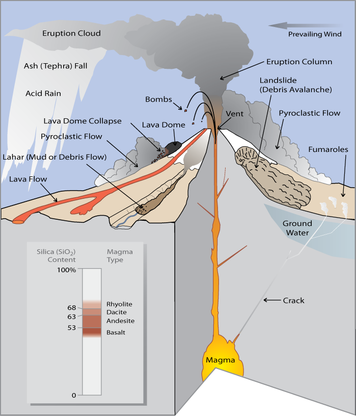
Diagram illustrating the most prominanr volcanic hazards
Source: USGS
Strength of volcanic eruptions (Volcanic Explosivity Index or VEI)
Volcanoes can erupt gently or violently, the violent eruptions being the most hazardous. The explosive strength of any eruption is measured by the volcanic explosivity index (VEI), a logrithmic scale of 0 to 8 with 8 being the most violent (mega-colossal).
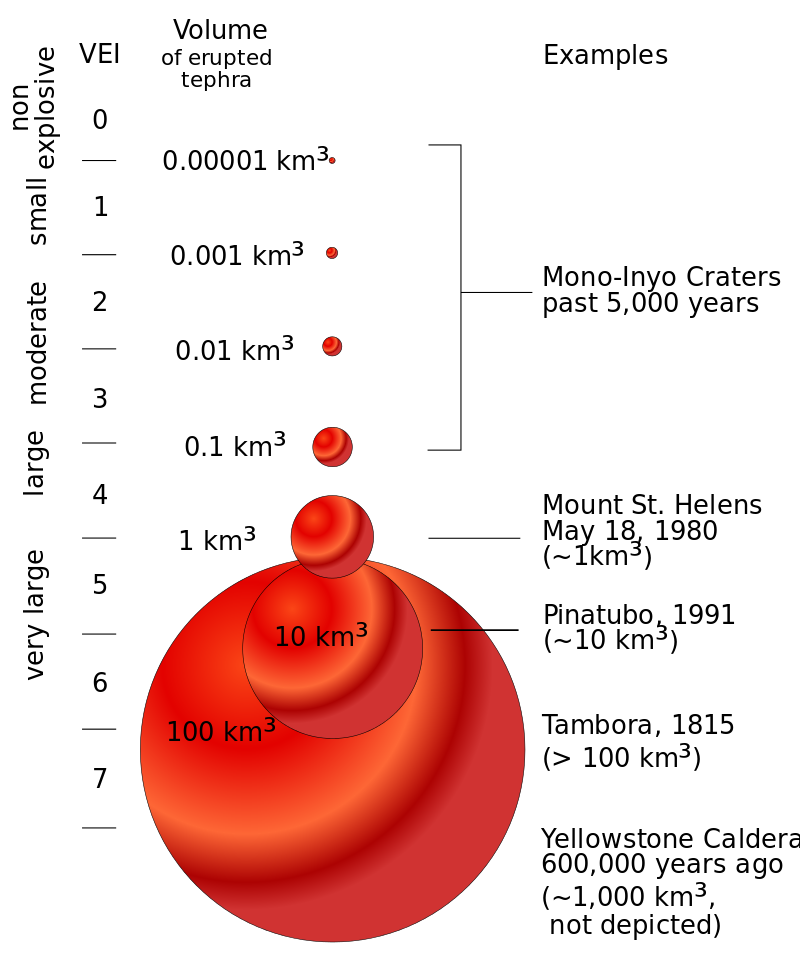
Diagram showing the explosive strength of erution (VEI) and total ejecta volume
Source:Wikipedia. See- https://en.wikipedia.org/wiki/Volcanic_explosivity_index
Examples of notable historic volcanic eruptions (VEI 5 to 7)
Mount St Helens 1980 CE - VEI 5, Cascades, Western USA. The deadliest and most economically destructive volcanic event in U.S. history, 56 killed. Pyroclastic flows produced by the eruption flattened vegetation and buildings over an area of around 600 km2.
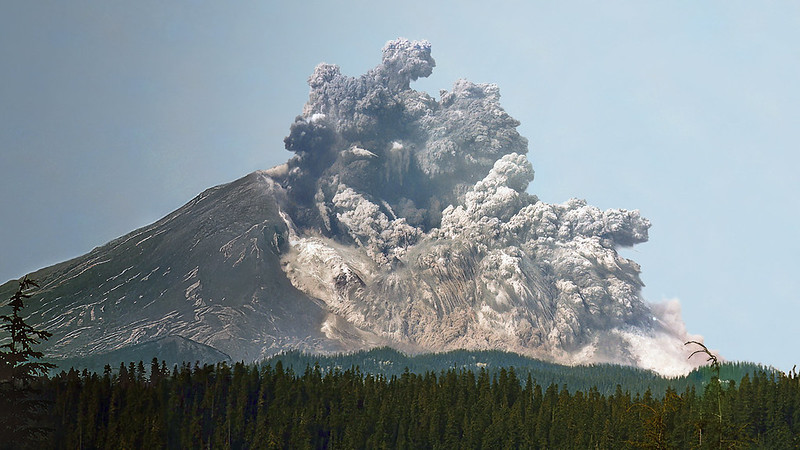
Violent eruption of Mount St. Helens, May 18, 1980
Source: https://www.flickr.com/photos/rosenow_photography/52796109334/
Vesuvius 79 CE - VEI 5 Gulf of Naples, Campania, Italy. Pyroclastic flows and ash from the 79 CE eruption of Vesuvius covered the Roman cities of Pompeii, Herculaneum, Oplontis, Stabiae and several other settlements causing more than 1000 fatalities. It is considered one of the most dangerous volcanoes, because 3 million people still live near enough to be affected by any future eruption.
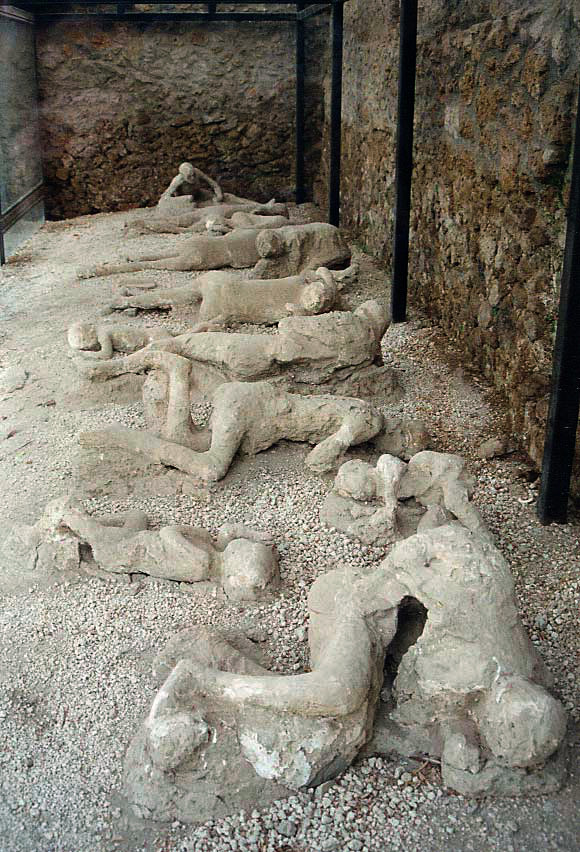
Victims of the 79 CE eruption of Vesuvius discovered during excavations in Pompeii
Source: Wikipedia. See - https://en.wikipedia.org/wiki/Eruption_of_Mount_Vesuvius_in_79_AD#/media/File:Pompeii_Garden_of_the_Fugitives_02.jpg
Mount Pinatubo 1991 CE - VEI 6, Central Luzon, Philippines. Second largest terrestrial volcanic eruption of the 20th century, 800 killed,
100,000 made homeless. Erupted 10 km3 of magma, massive quantities of pyroclastic flows and ash, and up to
20 million tonnes of sulphure dioxide. The SO2 ejected caused in a global 0.5 degree C decrease in temperature world-wide over the years 1991-1993.
After eruption collapsed to a 2.5 km wide caldera. Modern Pinatubo has over six
geologically mapped previous eruptive periods(starting from circa 79,000 BC), with the 1991 eruption being the smallest.
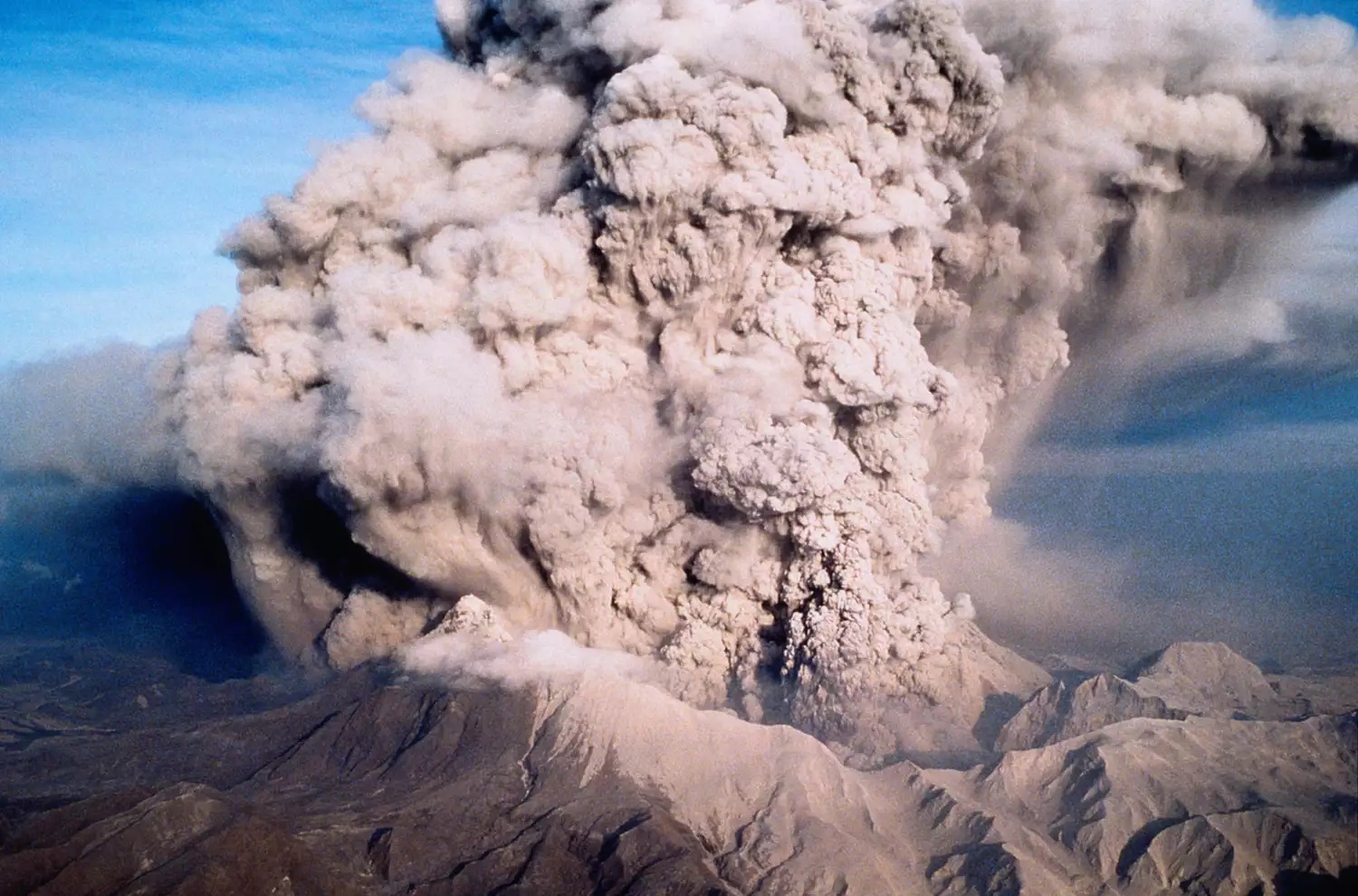
Violent eruption of Mount Pinatubo, June 15, 1991
Source: https://www.thoughtco.com/mount-pinatubo-eruption-1434951
Krakatoa 1883 CE - VEI 6, Sunda Straits, Indonesia. This VEI 6 eruption was equivalent to 200 megatons of TNT (4 times the yield of the Tsar Bomba (the largest nuclear device ever detonated), 25 km3 of rock ejected, explosion heard 5000 km away in Mauritius. Officially 36,417 people killed (mainly by tsunami created by the collapse of the volcano into the Sunda Sea) but more likely the real death toll was over 100,000. Has remained active since 1883 with the formation of a new island (Anak Karkatau) in 1927-1930. In 2018 Anak Krakatau itself erupted, creating a tsunami in which around 500 perished on the nearby islands of Java and South Sumatra.
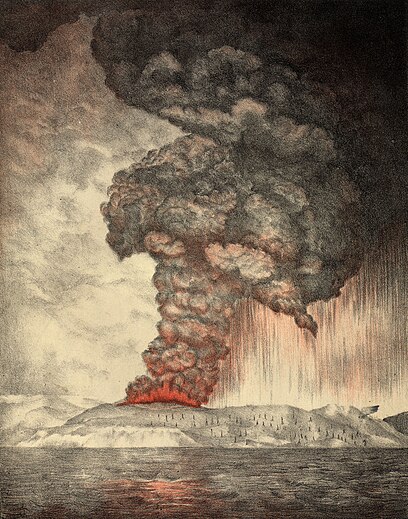
An 1888 lithograph of the 1883 eruption of Krakatoa
Source: Wikipedia. See - https://en.wikipedia.org/wiki/Krakatoa
Tambora 1815 CE - VEI 7,Sumbawa Island, Indonesia. Largest volcanic eruption in recorded human history. releasing 4 to 10 times the energy of the 1883 Krakatoa eruption. 100 cubic kilometers of pyroclastic erupted leaving a summit caldera measuring 7 kilometers across and 700 meters deep. Prior to eruption Mount Tambora measured 4,300 in height, one of the tallest peaks in Indonesia. After eruption elevation was reduced to just 2,851 meters. It is estimated that over 70,000 were killed, approximately 10,000 dirctly as a result of pyroclastic flows, the remainder from subsequent disease or hunger.
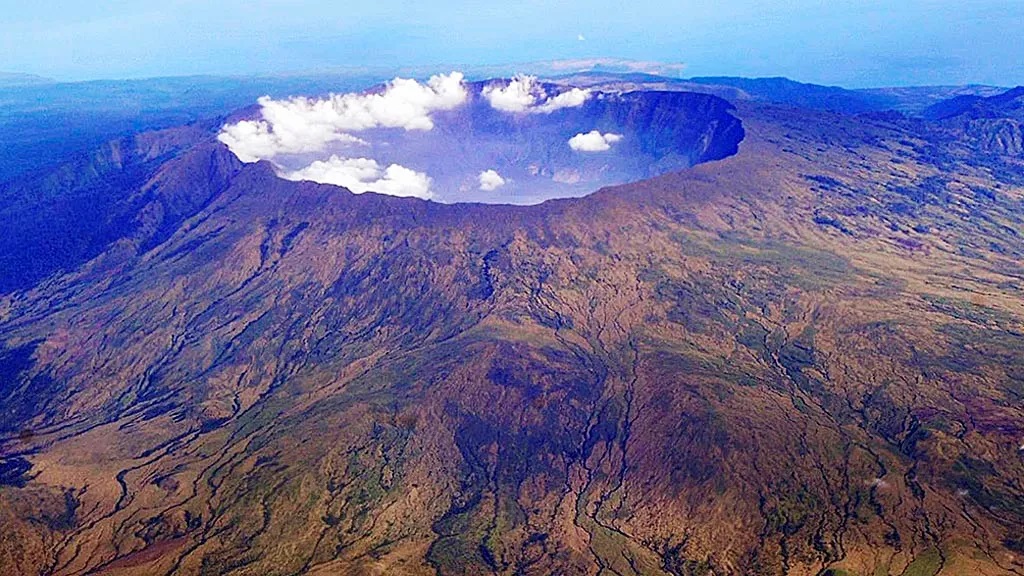
Remnant cauldera resulting from the volcanic eruption of Mount Tambora 1815
Source: Quartz. See - https://qz.com/894040/climate-changes-economic-and-political-effects-can-be-seen-in-the-1815-volcanic-eruption-of-mount-tambora
Super Eruptions (VEI 8)
Super eruptions are volcanic erutions that are massively explosive and which erupt vast quantities of material, sufficient to have the potential to create world-wide destruction and which can also significantly efect our climate over a long period of time. Luckily such eruptions are few and far between, but two such eruptions are well documented in the geological record, Yellowstone Cauldera in the USA and the Toba Cauldera in Sumatra, Indonesia. The Yellowstone Cauldera is of particular interest because many believe that it could erupt again!
Yellowstone Cauldera c. 640,000 BCE
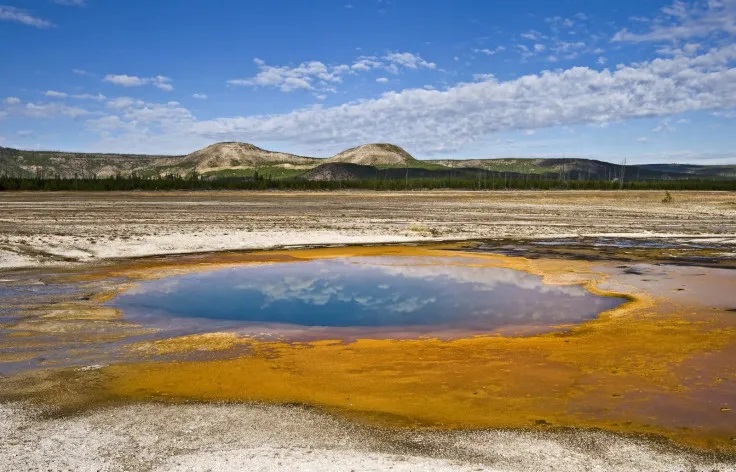
An opal thermal pool in the Yellowstone caldera
Source: International Business Times. See - https://www.ibtimes.co.uk/volcanic-super-eruption-that-could-wipe-out-civilisation-closer-first-thought-say-scientists-1649522
Toba Cauldera c. 70,000 BCE
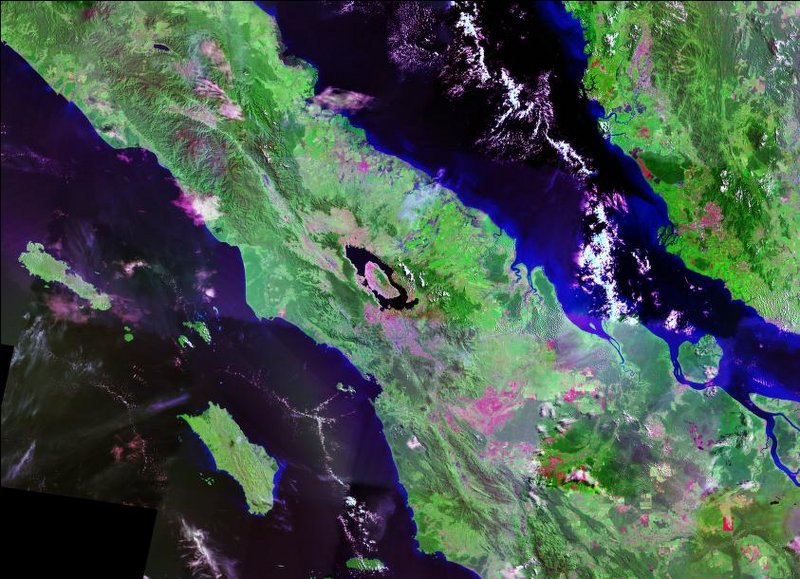
Lansat Image Lake Toba Cauldera, Sumatra
Source: NASA. See - https://en.wikipedia.org/wiki/Lake_Toba#/media/File:Toba_overview.jpg